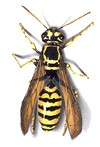  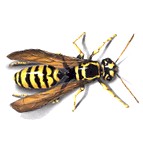 The Yellowjacket is a member of the wasp and hornet family Vespidae. in Alberta the most familar example is the Western Yellowjacket: Vespula pensylvanica. There are actually twelve species of yellowjackets in Alberta and seventeen in North America. In most of North America, yellowjacket colonies flourish during the summer and fall; they die off in the winter; only the queen survives. 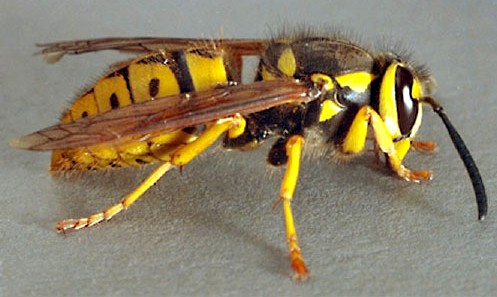 The Western Yellowjacket 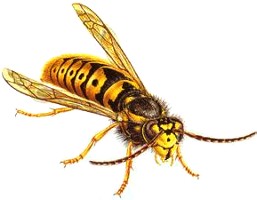 A single yellowjacket queen begins building a nest in the spring. She lays eggs to produce workers, which soon take over the nest-building, and also begin foraging for food. Meanwhile the queen continues laying eggs, which hatch as larvae and are continually fed until they pupate; adults
emerge from the pupas about three weeks later. A single yellowjacket queen begins building a nest in the spring. She lays eggs to produce workers, which soon take over the nest-building, and also begin foraging for food. Meanwhile the queen continues laying eggs, which hatch as larvae and are continually fed until they pupate; adults
emerge from the pupas about three weeks later.Workers searching for food will concentrate mainly on finding and killing other insects, such as flies and bees, within a hundred metres or so of the nest. They will continue to enlarge the nest until fall, when there may be as many as 1000 wasps living in it. In late summer, the queen produces eggs which become fertile females; these will become queens and leave the nest to mate, spending the winter alone in protected places under tree bark, in rotten logs, or sometimes in the walls of a house. The original nest is abandoned in winter; only the queen survives. She also spends the winter in a safe spot until spring. When a new season begins, old nests are not resused. 
Yellowjacket wasps can be up to an inch long. They are distinctive not only because of their black and yellow, or sometimes black and white, colour, but also because their bodies have a definite waist and they fold their wings lengthwise. Like other wasps, yellowjackets chew bits of wood and leaves to make a paste, which they shape into a paper-like nest. Yellow jackets build their nests in the ground or attached to branches. Sometimes they will make one in the walls of a building. The Western yellowjacket nests on the ground, often building a nest under porches or in cracks in structures. Unlike many other wasps, which are exclusively predators, the western yellowjacket is also a scavenger ... it is particularly attracted to garbage and anyhting with sugar in it. This scavenging makes it a pest, but it is what allows it to survive late into the fall. 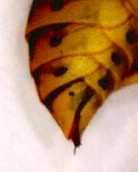
 If a nest of yellowjackets is disturbed, workers will aggressively defend it by stinging. Yellowjackets can sting more than once. Usually a sting is just a temporarily painful experience, resulting in redness, itching and pain. A hollow stinger is located at the rear of the yellowjacket's body. When it penetrates the skin, venom is injected through the stinger. It takes about 1,500 stings to kill an adult man. If a nest of yellowjackets is disturbed, workers will aggressively defend it by stinging. Yellowjackets can sting more than once. Usually a sting is just a temporarily painful experience, resulting in redness, itching and pain. A hollow stinger is located at the rear of the yellowjacket's body. When it penetrates the skin, venom is injected through the stinger. It takes about 1,500 stings to kill an adult man.
For people who are allergic, a single sting may result in a serious reaction, or in some cases, death. Between 0.5 and 1.0 percent of the population may be allergic to yellowjacket venom. Yellowjackets are also sometimes responsible for infection ... a contaminated stinger can inject bacteria beneath the victim's skin, causing blood poisoning.   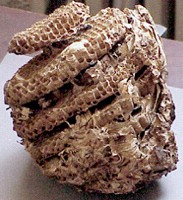 |